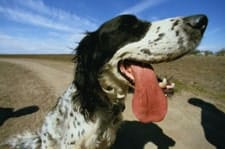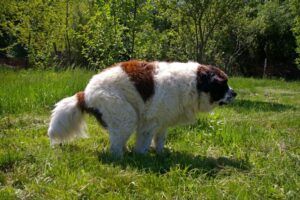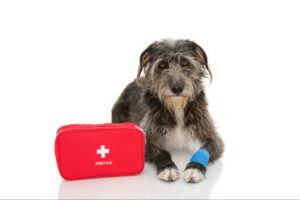
During the dog days of summer one thing to be wary of as the temperatures climb is heat stroke. Heat stroke in dogs is a dangerous rise in body temperature greater than 104 degrees Fahrenheit caused by prolonged exposure to high ambient temperatures. This is typically the result of being confined in a car or left outside on a hot and humid day with inadequate shelter. Another form of heat stoke is exertional which occurs when dogs are exercised for too long on hot humid days. A body temperature of greater than 109 results in multiple organ dysfunctions and if not treated promptly can result in death.
Dog’s Cannot Cool Down Like Humans
Unlike humans, dogs cannot cool off by sweating. The only sweat glands they have are in the pads of their feet and they are insufficient to cool them down adequately. The main way dogs keep their cool is by panting. This is important to remember because it allows us to identify factors that predispose to heat stroke so that we can take extra precautions to prevent it. Humidity greatly impairs a dog’s ability to cool off by panting. Keep an eye not only on the temperature but also on the heat index which combines the air temperature and relative humidity so you have a better idea how hot your dog will feel outdoors. In general, use extreme caution when the heat index is over 90 degrees and try to avoid having your dog outdoors when the heat index is over 100 degrees. Keep in mind that heat index is a measure of how hot it feels outside in the shade. Direct exposure to sunlight can increase the heat index by as much as 14 degrees! So make sure your dog has access to shade on those hot and humid summer days or better yet keep him indoors.
Health Concerns
Any condition that decreases a dog’s ability to pant will predispose them to heat stroke. This includes respiratory conditions such as laryngeal paralysis, tracheal collapse and brachycephalic obstructive syndrome. Brachycephalic breeds have short noses and flatter faces and include common breeds such as Pugs, Pekingese, Bulldogs, Boston Terriers and Shih Tzus. These breeds tend to have traits that make it harder to cool down via panting such as elongated soft palates and narrow nostrils. Obesity increases heat intolerance since the fat adds another layer of insulation and the increased weight makes panting a little harder. Other conditions that predispose to heat stroke are heart conditions and pregnancy. If your dog has any of these risk factors take extreme caution when out and about on a hot summer day.
Things to Keep a Watch For
Signs to watch for are excessive panting, weakness or collapse, drooling, incoordination, vomiting and sometimes seizures. If you notice these signs place your dog in a cool environment, check his body temperature with a rectal thermometer that you should have in your first aid kit and seek veterinary attention immediately. If the temperature is over 105, try applying alcohol to the pads of the feet, placing a cool wet towel over your dog for a few minutes and then removing it during transportation to your vet. Avoid cold water immersion as it can cause aspiration, severe hypothermia and shock. Stop cooling measures if the temperature goes down to 103 since continued cooling may result in body temperatures that are too low.
Prevention is Essential
However, prevention is the best remedy. Avoid leaving your dog in the car for any amount of time in warm weather; a car can quickly turn into an oven in a matter of minutes. Provide ample shade and water whenever your dog is outdoors. If you exercise with your dog, watch for clinical signs of heat exhaustion and stop if you feel hot since your dog likely feels the same way. If your dog has a long coat, consider keeping it shorter during the summer but be sure to keep them out of direct sunlight as they can get sunburns if their coat is too short. If any of the aforementioned risk factors apply to your dog then take extra precautions and avoid the heat as much as possible. By being aware of the risks, taking precautions and keeping a cool head you can have one cool dog this summer.











